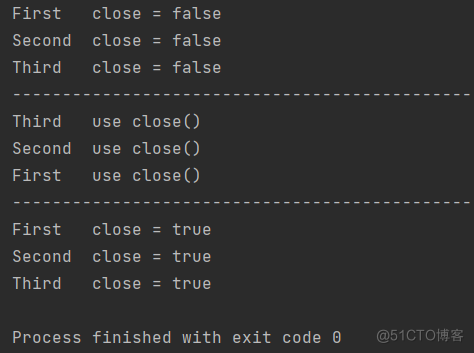try-with-resources 语法特点 ①资源说明头()中可以包含多个定义,用分号隔开(最后的分号可以省略)。资源说明头()中定义的每个对象都会在try块的末尾调用其close()。②try-with-resources的
try-with-resources 语法特点
①资源说明头()中可以包含多个定义,用分号隔开(最后的分号可以省略)。资源说明头()中定义的每个对象都会在try块的末尾调用其close()。 ②try-with-resources的try块可以独立存在,没有catch或finally都行。 ③实现了AutoCloseable的类都可以使用try-with-resources。 ④资源说明头()中对象的close()方法调用与创建对象的顺序相反。
案例展示
/** * @author 谢阳 * @version 1.8.0_131 * @date 2023/1/10 10:51 * @description */ public class TryWithResources { public static void main(String[] args) throws NoSuchFieldException, IllegalAccessException, InstantiationException { try ( First first = new First(); Second second = new Second(); Third third = new Third() ) { First.showState(); Second.showState(); Third.showState(); System.out.println("----------------------------------------------"); } System.out.println("----------------------------------------------"); First.showState(); Second.showState(); Third.showState(); } } class MyCloseable implements AutoCloseable { @Override public void close() { // 通过反射修改close的值 try { Field field = this.getClass().getDeclaredField("close"); field.setAccessible(true); /* setXXX 只适用于基础类,如果对象的字段是包装类采用set(Object obj, Object value) */ field.setBoolean(this.getClass().newInstance(), true); } catch (Exception e) { e.printStackTrace(); } System.out.println(this.getClass().getSimpleName() + "\tuse close()"); } } class First extends MyCloseable { protected static boolean close = false; public static void showState() { System.out.println(First.class.getSimpleName() + "\tclose = " + close); } } class Second extends MyCloseable { protected static boolean close = false; public static void showState() { System.out.println(Second.class.getSimpleName() + "\tclose = " + close); } } class Third extends MyCloseable { protected static boolean close = false; public static void showState() { System.out.println(Third.class.getSimpleName() + "\tclose = " + close); } }控制台输出

